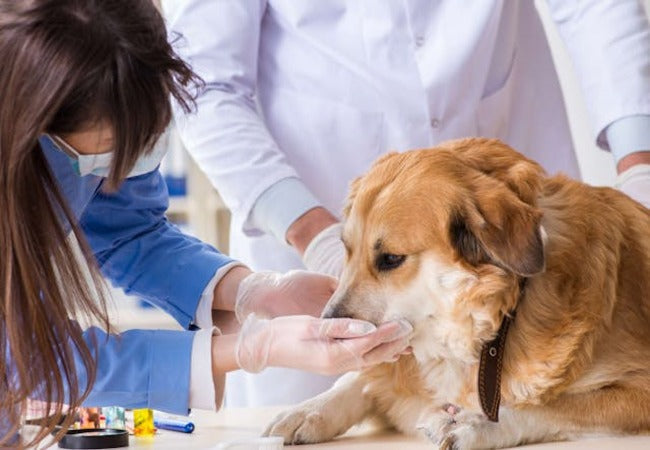Vet’s 2025 Guide to Canine Petroleum Hydrocarbon Toxicosis 🐾 When Household Products Poison🩺

In this article
Vet’s 2025 Guide to Canine Petroleum Hydrocarbon Toxicosis 🐾 When Household Products Poison🩺
By Dr. Duncan Houston BVSc
💡 Introduction
Petroleum hydrocarbon toxicosis occurs when dogs ingest, inhale, or come into skin contact with petroleum products—like gasoline, kerosene, solvents, waxes, and lubricants. These products can cause severe respiratory damage, chemical pneumonitis, neurological issues, gastrointestinal upset, and systemic toxicity.
1. How It Happens
Toxic exposure occurs via:
- Ingestion—drinking gasoline, licking oily fur, grooming after contact.
- Inhalation—fumes from spilled petroleum or during grooming-induced aspiration.
- Dermal contact—soaking in oil or solvent, followed by licking.
2. Which Products Are Most Dangerous
- Low-viscosity, volatile hydrocarbons—gasoline, kerosene, naphtha—pose high aspiration risk.
- Aromatic hydrocarbons (benzene, toluene, xylene) cause systemic effects (respiratory, cardiovascular, neurological).
- Heavier oils (motor oil, lubricants) are less acutely toxic, but cause GI irritation and long-term ingestion effects.
3. Clinical Signs & Systems Affected ⚠️
- Respiratory: coughing, choking, gagging, tachypnea, dyspnea, aspiration pneumonia/chemical pneumonitis—most critical sign.
- Gastrointestinal: vomiting (especially oily), diarrhea, abdominal pain, oily feces up to 2 weeks later.
- Neurological: depression, confusion, incoordination (“drunken gait”), tremors, seizures in severe cases.
- Dermal and oral: irritation, salivation, pawing at face, skin redness or burns.
- Cardiac: arrhythmias, cyanosis, respiratory arrest in severe exposures.
- Systemic signs: fever, lethargy, dehydration, collapse, coma.
4. Diagnosis 🧪
4.1 History & Clinical Exam
- Owner description of odor, access to spills/liquids, grooming behaviors.
- Physical exam: respiratory distress, skin lesions, GI pain, neuro deficits.
4.2 Diagnostic Testing
- CBC/Chemistry/U&E: assess organ function, inflammation.
- Thoracic radiographs show aspiration pneumonia or pneumonitis.
- Pulse oximetry/ECG: monitor oxygenation and cardiac rhythm.
- Gastric/fecal content testing: confirm hydrocarbon presence.
5. Treatment in 2025 ❤️
5.1 Immediate Decontamination
- Do NOT induce vomiting—risk of aspiration is life-threatening.
- Skin decontamination: rinse with mild dish soap and water; clipping may be required.
- Wash eyes and muzzle: flush with water if ocular/ facial contact occurred.
5.2 Supportive Veterinary Care
- Oxygen therapy: cage, mask, or nasal cannula for respiratory distress; mechanical ventilation if needed.
- Intravenous fluids: support hydration, prevent bloat or hypotension.
- Antibiotics: only if secondary aspiration pneumonia is confirmed.
- Anti‑emetics and gastroprotectants: reduce vomiting and esophageal irritation.
- Cardiac monitoring/treatment: treat arrhythmias or myocardial sensitization.
- Neurologic care: anticonvulsants if seizures occur.
5.3 Monitoring & Follow-Up
- Continue pulse‑oximetry, ECG, and serial chest radiographs every 24–48 hours.
- Assess respiratory status during the recovery phase—some damage can be irreversible.
- Address long-term lung injury with anti‑inflammatory therapy if needed.
6. Prognosis
- If respiratory and neurologic signs resolve within 24–48 hours, prognosis is fair to good.
- Severe aspiration or neurologic toxicity increases the risk of permanent damage or death.
- Chronic or repeated exposure may cause persistent lung issues or organ damage.
7. Prevention 🔒
- Store gasoline, solvents, lubricants, and oils securely.
- Clean up spills promptly; lock garage or workshop access.
- Avoid using products around pets; use barriers and keep pets distant.
- Wash pets immediately after accidental contact.
- Educate family members, caregivers, and neighbors.
8. Ask A Vet Support 🩺
- 24/7 triage for suspected exposure or acute symptoms.
- Photo/video support for grooming, affected skin areas, and respiratory effort.
- Medication reminders (oxygen, antibiotics, anti-emetics).
- Symptom logs: breathing, appetite, neurologic function.
- Alerts for recurring symptoms, rechecks, x‑rays, or specialist referral.
🔍 Key Takeaways
- Petroleum toxicosis is a medical emergency—aspiration risk is highest threat.
- Diagnosis includes history, physical exam, imaging, and lab tests.
- Treatment focuses on decontamination, respiratory support, and monitoring.
- Prognosis hinges on the severity and timing of veterinary intervention.
- Secure home storage and quick cleanup prevent accidental poisoning.
- Ask A Vet offers real‑time guidance, monitoring, and peace of mind.
🩺 Conclusion ❤️
While many dogs recover from mild exposures, petroleum hydrocarbon toxicosis can rapidly evolve into life-threatening pneumonia or neurologic crisis in 2025. Timely decontamination, vigilant respiratory monitoring, and supportive ICU care greatly enhance recovery chances. Integrating Ask A Vet into follow-up ensures responsive care, giving every pet the best shot at a full return to health. 🐶✨
Dr Duncan Houston BVSc – combining emergency expertise with compassionate client support.
Visit AskAVet.com and download the Ask A Vet app for 24/7 exposure triage, treatment reminders, symptom logs, and guidance through every toxicologic event. ❤️






